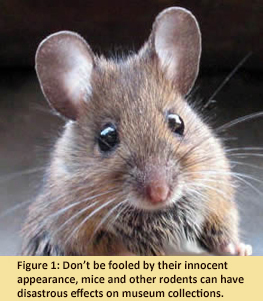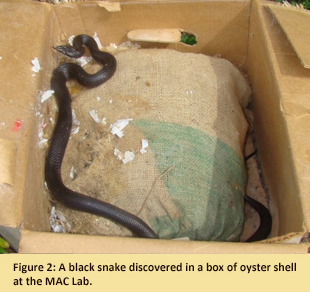Natural Approaches to Pest Management
April 2012
By Erin Wingfield, MAC Lab Collections Assistant
 Regular pest management is an important part of collections care. Pests, such as rodents and insects, can damage collections and their associated records leading to the loss of vital information. To mitigate this, most collections storage facilities and museums have a pest monitoring plan implemented by museum staff or a contract pest management company. This involves the use of sticky traps to capture pests, as well as regular monitoring for pest entry points, infestations, and damage.
Regular pest management is an important part of collections care. Pests, such as rodents and insects, can damage collections and their associated records leading to the loss of vital information. To mitigate this, most collections storage facilities and museums have a pest monitoring plan implemented by museum staff or a contract pest management company. This involves the use of sticky traps to capture pests, as well as regular monitoring for pest entry points, infestations, and damage.
Due to the current harsh economic climate, the Maryland Archaeological Conservation Laboratory (MAC Lab) has been looking for effective methods to reduce costs, while still providing the same level of care. There are also concerns about the use of harsh chemicals and pesticides. A more natural method is preferred. One new method currently being tested is the use of natural predators, such as snakes or cats, to control rodent populations.
Rodents are a nemesis of every collections manager (Figure 1). They devour and destroy organic materials, including paper, making their nests out of important records and labels. Rodents also have a habit of leaving behind mouse pellets and urine, which are not just disgusting, but are also a health hazard.
 Even though many humans have a fear of snakes, most snakes are not outwardly aggressive and can actually be considered beneficial (Figure 2). Most local snakes, such as this black rat snake, prefer to eat rodents and can be collections superheroes in the war against mice.
Even though many humans have a fear of snakes, most snakes are not outwardly aggressive and can actually be considered beneficial (Figure 2). Most local snakes, such as this black rat snake, prefer to eat rodents and can be collections superheroes in the war against mice.
Snakes do not require regular maintenance or extra feeding and can typically take care of themselves. Many snakes are strong climbers and can get into small, hard to reach places that a curator could never reach. For optimal use, these creatures are more suitable to outdoor barns and more open or exposed types of storage area. However, they will also happily take up residence in climate controlled storage facilities, if given the opportunity.
 There are some potential downsides to using snakes for rodent control, such as the occasional shed skin or an overly aggressive snake biting a staff member. However, snake bites can be kept to a minimum if only local, non-poisonous snakes are chosen. This strategy can also lead to the next inevitable pest problem, what to do with the snakes after the rodent problem is under control.
There are some potential downsides to using snakes for rodent control, such as the occasional shed skin or an overly aggressive snake biting a staff member. However, snake bites can be kept to a minimum if only local, non-poisonous snakes are chosen. This strategy can also lead to the next inevitable pest problem, what to do with the snakes after the rodent problem is under control.
Other facilities have chosen to go with an alternative pest management solution -- the cat (Figure 3). Cats require regular feeding and basic care but are relatively low maintenance. Cats have a well established relationship with humans, and many are just as effective at catching and deterring rodents as snakes. However, they may also choose to display their hunting skills by leaving dead rodents as gifts, which can be upsetting to some individuals and could potentially impact museum visitation.
The MAC Laboratory will continue to examine these and other possible pest management alternatives for the best methods of preserving our collections.
...... Happy April Fools!